
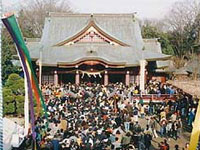
From the stroke of midnight on New Year's eve, hundreds of thousands of visitors fill the precincts of the Kasama Inari shrine, celebrating the new year and praying for the longevity of the imperial house, the safety of the nation, and for world peace, not to mention the good fortune and prosperity of each individual parishioner and worshiper during the coming year. The shrine precincts are filled with large numbers of visitors from New Year's eve into the next day, and the number of pilgrims to Kasama Inari during the month of January alone is the largest of any Shinto shrine or Buddhist temple in Ibaraki Prefecture.
This festival is held on the first day of the horse (according to the old astrological calendar) in the month of February. This seasonal period signals the transition from winter to spring, coinciding with the reemergence and renewed activity of plants and other forms of life. The festival thus celebrates the new year's revival of life and the renewed beginnings of all things.
At Kasama Inari Jinja, this festival offers prayers to the deity for successful maturation of the year's harvest and prosperity for industry, while also beseeching world peace and national safety.
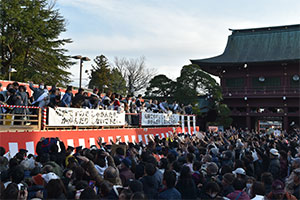
February 3 or the day before the spring equinox is considered the last day of winter, and on this day, a festival is held to drive out noxious spirits and invoke good fortune. At Kasama Inari, following completion of the official ritual at the Hall of Worship, a specially constructed platform in the shrine precincts is the site for the performance of an ancient ritual of driving out evil (tsuinashiki) using peachwood bows, reed arrows, and peachwood staves. Some 300 officiants dressed in traditional formal attire throw out good-luck beans and cash specially prepared according to secret techniques passed down through the family of the shrine's chief priest.
Also on that day, special gold emblems are distributed as talismans for personal safety.
Japan's deepest cultural roots originate in agriculture, and within the ritual calendar, two of the most important observances are the prayers for a good harvest in spring, and the festival of harvest thanks in autumn. The kinensai is also called toshigoi no matsuri, where toshi refers to the harvest of grains (goi or koi means "entreaty") ; it is observed near the beginning of each year, raising prayers to the kami for a good harvest, and for the safety of the nation. Today, the festival's significance has broadened to include more general prayers for a full and satisfying life during the year, and for home safety, business prosperity, success in school examinations and other more concrete mundane desires ; in turn, supplicants also offer their vows to give their own full efforts to assure the successful fruition of their entreaties.
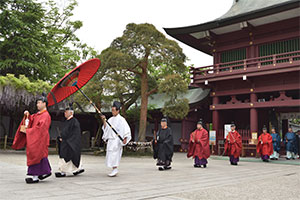
Kasama Inari's major annual festival is held on April 9, the shrine's legendary founding day. On that day, ritual offerings of incense ceremony and tea ceremony are made at the Hall of Worship, together with offerings of famous rice wines (sake) from more than seventy breweries located in Ibaraki Prefecture.
Within the shrine precincts, exhibitions of flower arranging (ikebana) are presented by various Ohararyu, while outdoor tea ceremonies are performed by members of the Edo Senke, Omote Senke and Ura Senke schools of tea.
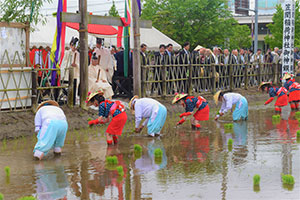
The festival of rice transplanting or taue is observed at a special site prepared at the shrine's sacred rice fields at the time of the spring transplanting of the new rice seedlings. At that time, special prayers are offered to the deity Inari okami for successful maturation of the grain. In conjunction with the divine rites, the special divine dances Inarimai and Karyobin are exhibited at the Hall of Sacred Dance, and to the accompaniment of traditional rice transplanting songs, the seedlings are transplanted in accordance with ancient custom by parishioners and selected young women.
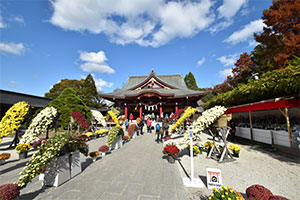
Begun in 1890, Kasama Inari's Chrysanthemum Festival is Japan's oldest. In 1908, shrine gardens were established as a place for the exhibition of chrysanthemum flowers, thereby providing parishioners with a calming atmosphere, and stimulating their sense of closeness to the earth ; since that time, the shrine's Chrysanthemum Festival has grown larger each year. In 1948, an exhibition of "chrysanthemum mannequins" - human figures formed from chrysanthemum blooms - was added ; the festival is now known as one of Japan's representative flower celebrations, drawing some 600,000 visitors from throughout the nation.
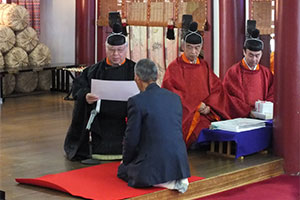
Each November 23, thanks are given in this festival for the abundant harvest and success in other productive endeavors. Specially consecrated offerings are presented to the kami at this time, together with first fruits of harvest and sericulture, and prayers are offered for future blessings.
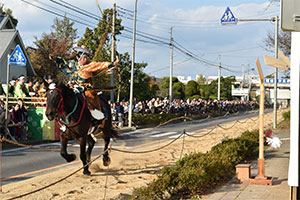
This ceremonial form of equine archery is observed as a form of divination for the year's harvest - a subject with strong associations to the deity Inari. Each November 3, members of the Ogasawara school of mounted archery perform the rite at a special archery facility in accordance with ancient precedent ; the observance is one of the three major performance of yabusame in the Kanto Plain region.
In addition, the Ogasawara school also performs the sansanku tebasami ritual on the day of the autumnal equinox (September 23).